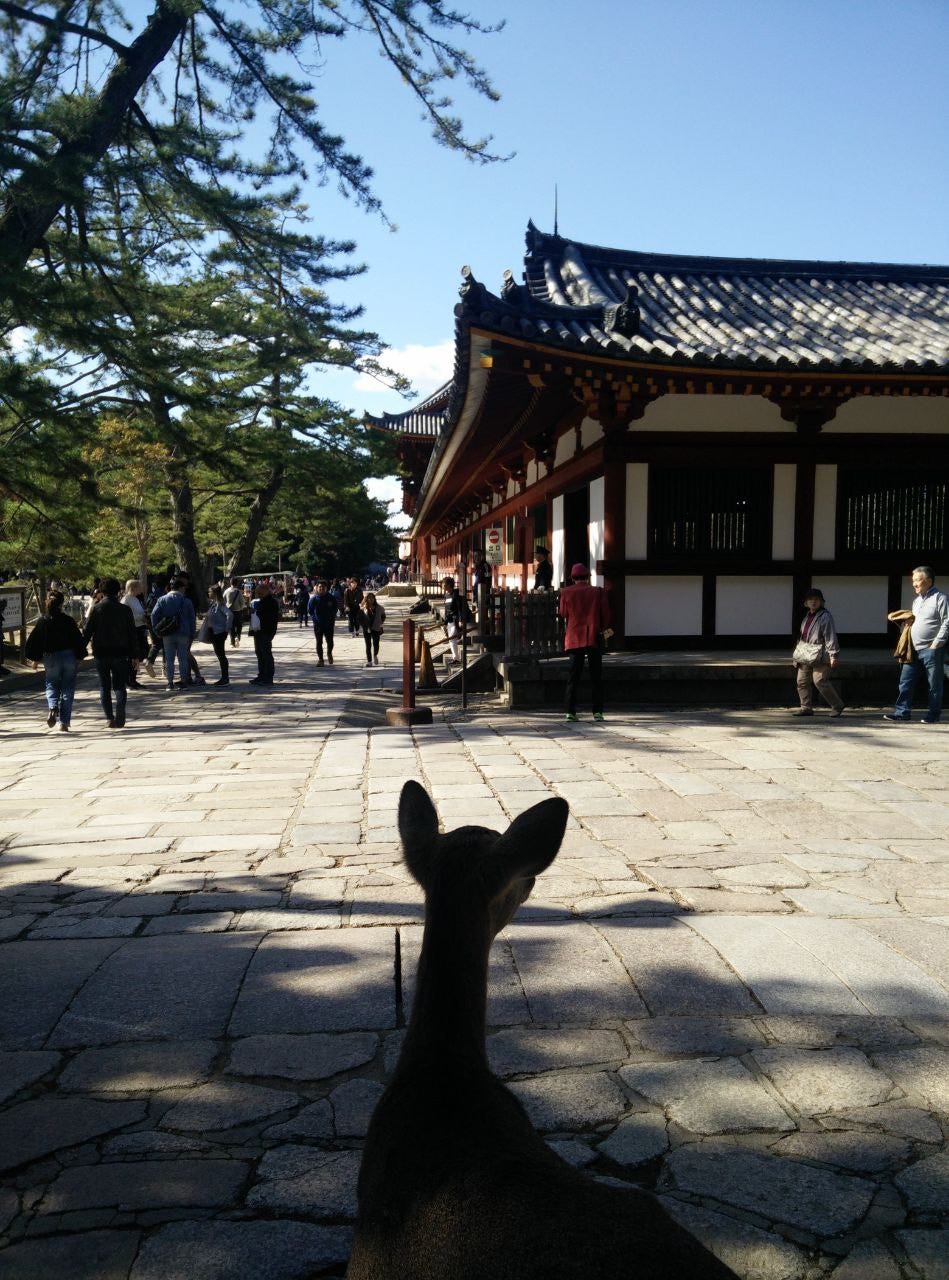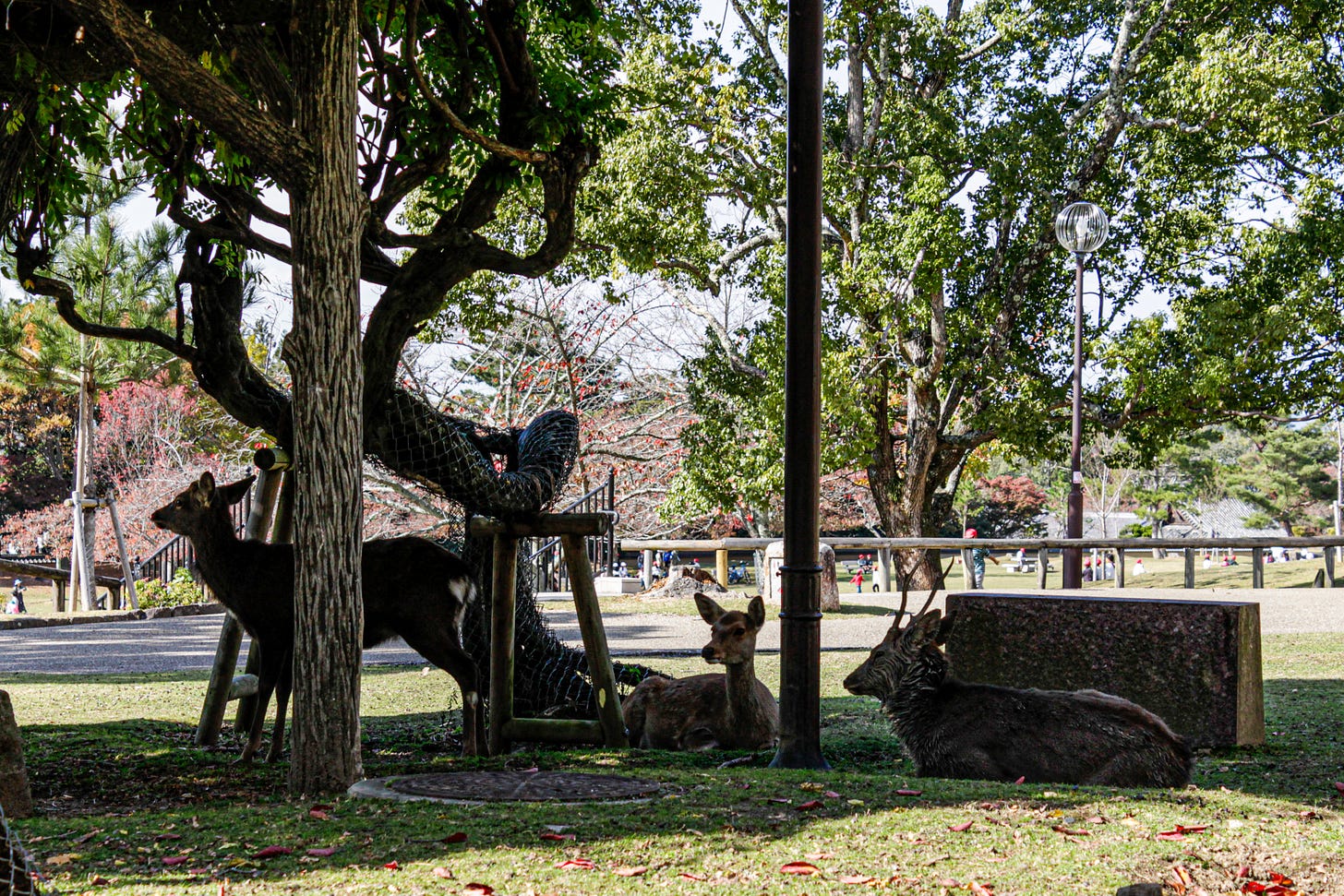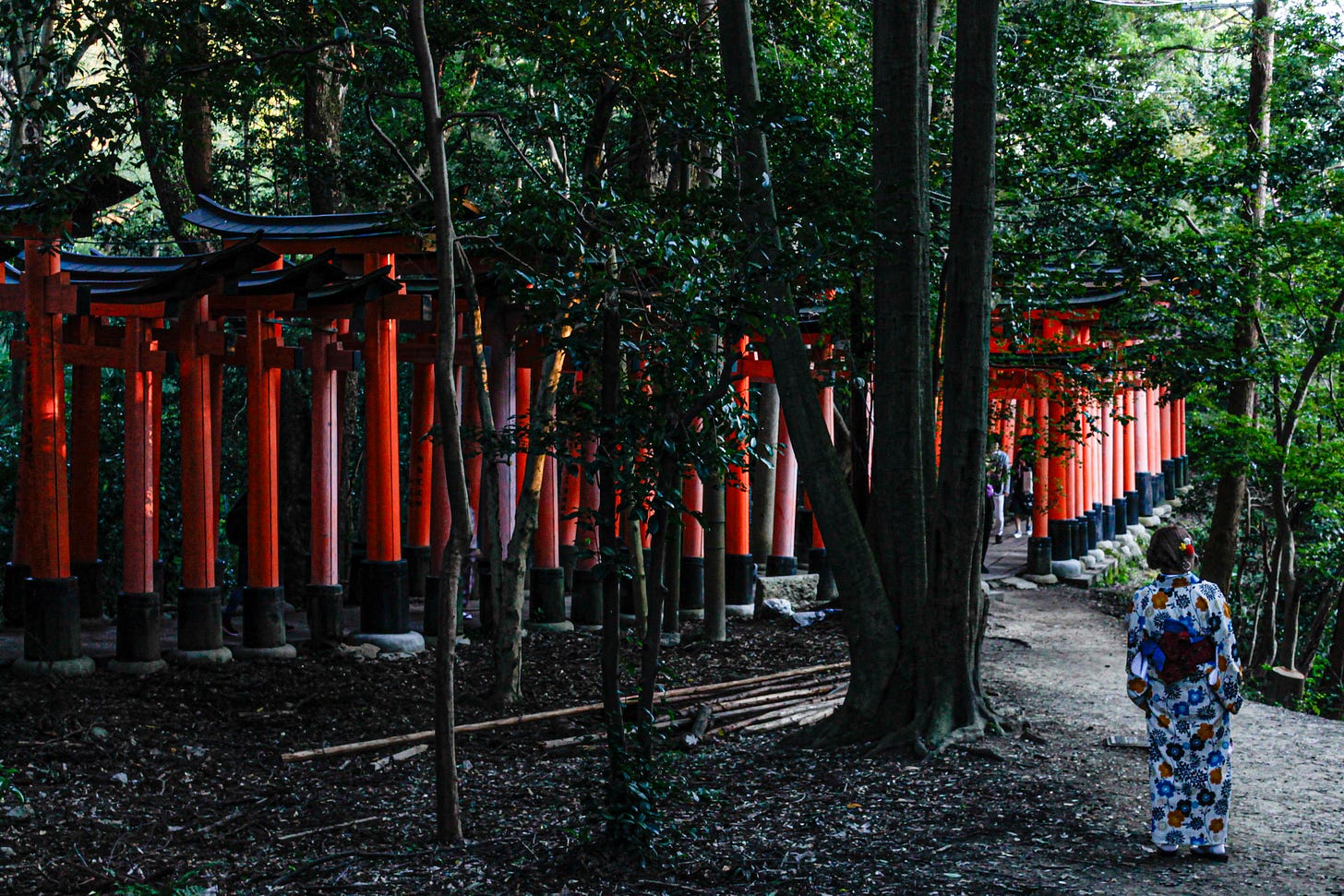In Autumn 2019 I travelled for one month in Japan, I volunteered for two weeks in a village on Kyushu island and, for the other two, I visited the most famous cities in the country.
I left Osaka by train and in around 30 minutes I arrived in Kyoto. I had lunch in an Izakaya at the train station and after I went to meet Hiroko, who would host me for three nights. I will tell you about Kyoto and Hiroko another time because in this article I want to talk about a day trip to Nara and Fushimi Inari while I was in Kyoto.
Nara is a history and culture treasure trove, boasting ancient temples, serene gardens, and friendly deer roaming its parks. As the country's first permanent capital, Nara is steeped in tradition and spirituality, evident in its well-preserved temples such as Todai-ji, home to the Great Buddha, and the colourful Kasuga Shrine.
I've been there just half a day, and it could be enough if you don't have more time, but I could have stayed longer because it's an amazing city, with a lot of temples and amazing places to see.
During my stay in Kyoto, I decided to spend one day out of the city, in the morning I took a train and 45 minutes after I was in Nara. Getting out of the station and walking in the direction of the city centre I stopped by Kofuku-ji, one of Nara's most significant Buddhist temples, renowned for its majestic pagoda and historical significance. Founded in the 7th century, it served as the head temple of the influential Hosso sect. The temple complex, once sprawling, still retains its grandeur with key structures like the five-story pagoda, a symbol of Nara's ancient capital. I never got tired of these pagodas, there are a lot of them in Japan, and almost every temple has one, but I always liked them, it's something unusual to see as a European.
It is site number 9 of the Saigoku Kannon Pilgrimage, which is a pilgrimage of 33 Buddhist temples throughout the Kansai region. Kofuku-ji temple was once one of the powerful Seven Great Temples in the city of Nara. The temple was damaged and destroyed by civil wars and fires many times, and some buildings or parts of them were never reconstructed and are missing today.
Left Kofuku-ji and walked directly to Todai-ji, one of Japan's most iconic and historically significant temples. Constructed in the 8th century, it houses the Daibutsuden, the world's largest wooden building, which enshrines a colossal bronze statue of Buddha, known as the Great Buddha (Daibutsu). The temple played a central role in the spread of Buddhism in Japan and served as the headquarters of the Kegon school of Buddhism. Todai-ji's immense cultural and religious importance is evident in its architectural grandeur and the spiritual atmosphere that permeates its grounds.
Also this temple was part of the powerful Seven Great Temples in the city of Nara, it is listed as a UNESCO World Heritage Site as one of the "Historic Monuments of Ancient Nara".
Visiting Todai-ji was a profound experience, I marveled at its architectural and spiritual significance.
While I was in front of it enjoying the view some kids on a school trip approached me reading from a paper some questions in English: where are you from? how old are you? what is your favourite Japanese food? they were probably doing a school assignment, and it was a funny situation, I answered their questions and at the end, we had a picture together.
Getting out of the temple I decided to walk around Nara Park, a picturesque landscape blending nature, history, and spirituality. Spanning over 1,200 acres, it is home to iconic landmarks such as Todai-ji Temple and Kasuga Shrine. I enjoyed strolling through the park's lush greenery, feeding the friendly deer, and admiring the serene ponds and gardens. Nara Park offers a peaceful escape from the hustle and bustle of city life, inviting you to connect with nature and immerse yourself in Japan's cultural heritage.
Nara Park was established in 1880 and it is one of the oldest parks in Japan, over 1200 sika deer are freely roaming there. These animals were considered divine and sacred, for example till 1637 killing one of them was punishable by death, after WWII the deer were officially classified as a natural treasure.
In Nara, Sika deer roam freely throughout Nara Park, adding a unique charm to the city's ambience. These gentle creatures are considered sacred messengers of the gods in Shinto tradition and have become an iconic symbol of Nara. You can often be seen feeding the deer special crackers called "shika senbei," available for purchase around the park. The deer are friendly and accustomed to human interaction, often approaching you in search of food. Their presence creates a harmonious atmosphere, allowing you to connect with nature and experience a close encounter with these beautiful animals amidst the historical and cultural heritage of Nara.
The other landmark in the park is Kasuga Taisha, a revered Shinto shrine known for its striking vermilion buildings and atmospheric stone lanterns. Established in the 8th century, it is dedicated to the deity responsible for protecting the city and its people. The shrine is renowned for its unique architectural style, characterized by the use of deep vermillion colour and intricate woodwork. Its most distinctive feature is the thousands of stone lanterns lining the pathways, which are lit twice a year during the Lantern Festival, creating a magical ambience.
Ema are small wooden plaques commonly found at Shinto shrines. These plaques, often adorned with colourful illustrations or designs, serve as a means for visitors to convey their prayers or wishes to the gods. Visitors typically purchase ema from the shrine's gift shop, then write their wishes or prayers on the blank side of the plaque before hanging it up on designated racks or boards. The ema are believed to act as a conduit between the worshipper and the divine, carrying their hopes and desires to the kami (spirits or gods) of the shrine.
During this trip to Japan sometimes I stopped by the racks to check some Ema, most of them were written in Japanese or Chinese, but there were some in Italian or English, and some with funny drawings.
I liked Kasuga Taisha; the lanterns around the shrines were beautiful. There was a dark room with them lit up, and the vermilion colours added a serene ambience to the surroundings.
On the way back to Kyoto I decided to stop by Fushimi Inari Taisha, which is an hour train ride from Nara. It is a renowned Shinto shrine famous for its thousands of vibrant orange torii gates that form a tunnel-like pathway through the forested hills of Mount Inari. Dedicated to Inari, the Shinto god of rice and prosperity, the shrine attracts millions of visitors each year who come to admire its mystical ambience and breathtaking scenery. The torii gates, donated by individuals and businesses as offerings of gratitude or prayers for good fortune, create a mesmerizing spectacle as they wind their way up the mountainside. I hiked along the trails, passing through the gates and exploring the serene forest paths dotted with smaller shrines and stone fox statues (kitsune), believed to be messengers of Inari.
Fushimi Inari is touristy and crowded, especially at the beginning of the torii tunnel-like pathway, what I suggest is to be patient and walk after the first part, or go in the early morning, it's open 24 hours.
Fushimi Inari Taisha is one of the oldest and most important Shinto shrines in Kyoto, dating back to the 8th century. The most iconic feature is its Senbon Torii, or "thousands of torii gates." The hike up the mountain can take about 2-3 hours round trip, but you can choose how far you'd like to go. I hiked randomly till a point where I had a stunning view of Kyoto, I don’t know how much I hiked I was just enjoying the surreal atmosphere of the forest with the Senbon Torii. Along the way, there are rest stops, and tea houses, where you can take a break and enjoy the peaceful surroundings.
At sunset, I decided to go to the train station to get back to Kyoto and have dinner with Hiroko, but as I said before this story is for another time.
See you soon,
Flavio




































Love the temples! When I was in Thailand, it was temple heaven.
Love both Nara and Kyoto! The deers are so cute and the temples astonishing. The Fushimi Inari looks so different in real life that it was a big surprise for me.